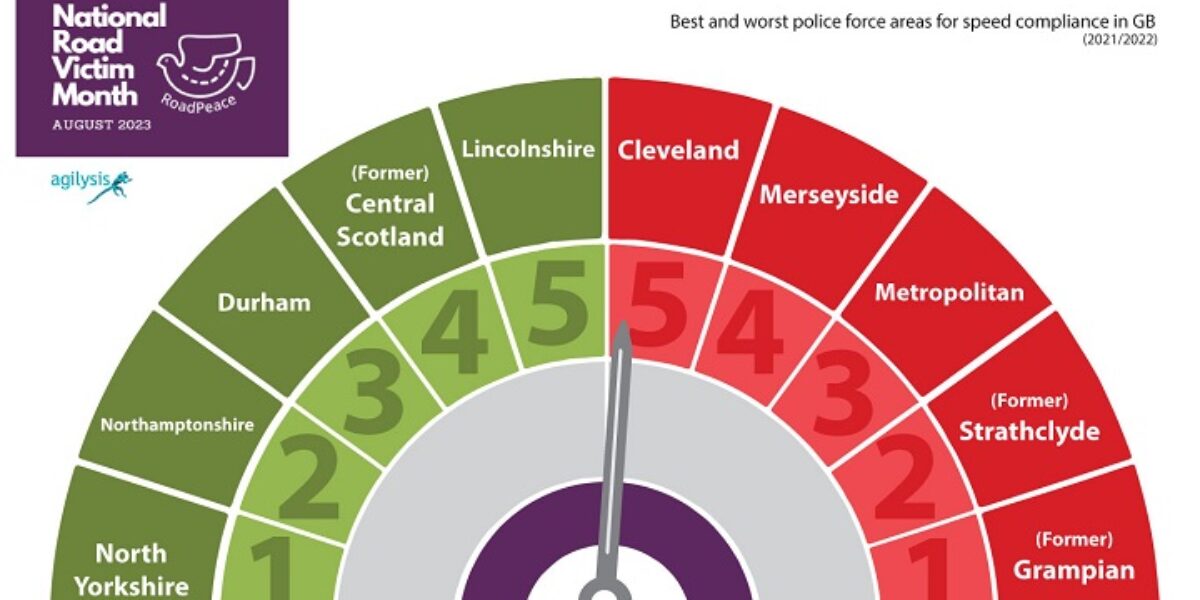Watching the speedo
Connected vehicles providing essential data as revealed by RoadPeace
True compliance with speed limits in the UK have been revealed using evidence from connected vehicles.
As cars become more digitally interconnected, the data is providing valuable insights into road safety.
RoadPeace, the national charity for road crash victims, has been provided with exclusive data that it has analysed and published.
Real time evidence
These pioneering figures were analysed by transport data experts Agilysis. The raw data was provided by Basemap.
It highlights for the first time, the police force areas where drivers exceed the speed limit more excessively than others.
This release coincides with National Road Victim Month (August) in the UK. It highlights the risks posed by vehicles driving at excessive and inappropriate speeds every day on our roads.
The five most speed compliant counties
(based on data collected between April 2021 and March 2022):
| Drivers speeding, by police force area | Percentage of drivers exceeding the speed limit |
| North Yorkshire | 3.05% |
| Northamptonshire | 3.94% |
| Durham | 4.43% |
| Central Scotland | 4.90% |
| Lincolnshire | 5.02% |
The five least speed compliant counties
| Drivers speeding, by police force area | Percentage of drivers exceeding the speed limit |
| Grampian, Scotland | 12.65% |
| Strathclyde, Scotland | 12.34% |
| London (Metropolitan Police area) | 11.38% |
| Merseyside | 10.39% |
| Cleveland | 9.75% |
Plain wrong
Nick Simmons, CEO of RoadPeace, believes speeding should be as socially unacceptable as drink driving.
“Speeding is a major contributory factor in the majority of collisions on our roads – it shatters lives, destroys families and communities live in fear of it – so why don’t we see speeding as the antisocial epidemic that it is?
“We hope by sharing the stories of some of our members, whose lives have been torn apart by speeding drivers, who have courageously told their stories, that people will think twice before putting their foot down. Speeding is selfish, unfair and it puts so many lives at risk.”
The national charity for road crash victims, has produced a series of videos – Victims Voices. Funded by the Department for Transport, they are designed to raise awareness around the devastating impact of speeding.
These videos are being shared throughout the month to urge drivers to think twice about speed.
Connected vehicle data
The majority of modern private and commercial vehicles on our road network are now ‘connected’ to the internet. It means thy are transmitting data in real time, all the time.
This data is used to calculate both the average and high-end (85th percentile) speeds across the whole road network. This can be matched to local speed limits and aggregated by police force areas to show the percentage of vehicles breaking the speed limits.
The data in this particular sample was taken between April 2021 and March 2022, and based on 14 billion journeys on roads across Great Britain.
Richard Owen, CEO of Agilysis, said: “For the first time we are able to gauge levels of compliance to speed limits and quickly identify any problem areas for targeted improvements in safety.
“As vehicles become more connected, the data they provide gives incredible insight into how the roads are being used at all times.”
Prevention is the cure
The data signals a major step forward in road casualty reduction. Local authorities and police forces now able to understand where drivers are exceeding the speed limits before collisions occur. It also provides a wealth of other data about potential danger hotspots, particularly dangerous junctions or particular roads.
This intelligence will help them to increase preventative measures on problematic routes, such as increased enforcement or improved engineering.
Previously it was a labour-intensive surveying exercise and relied heavily on waiting for crashes to happen in order to take action. Connected data is providing a wealth of information that could be assessed and utilised before casualties mount and victims and their families suffer.





